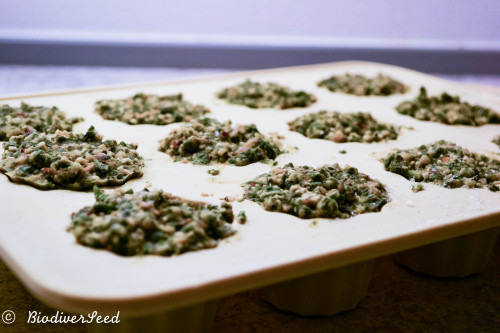ubcbotany:biodiverseed:EAT THE WEEDSA weed is a plant that has mastered every survival skill e
ubcbotany: biodiverseed: EAT THE WEEDS A weed is a plant that has mastered every survival skill except for learning how to grow in rows. -Doug Larson There is a very persistent weed in my yard: here it’s called “Skvalderkål”; in English, the common name is Ground Elder. Kål is actually the Danish word for “Cabbage,” and this plant is so-called because the young leaves are surprisingly tasty, very nutritious, and have been used as both a food and medicine for hundreds of years. Now forgotten as a food-source, it runs amok and wreaks havoc in flower beds. I am determined to contain the rapid spread of this plant, so today I went out an harvested a bunch of it: repeated harvesting will starve the roots and make the invasions less aggressive, giving me a chance to dig out the rhizomes and plant what I desire instead. From this harvest, I made a tonne of pesto and froze it in individual portions. I also made veggie Frikadeller batter out of the leaves for dinner tomorrow. I’m going to have to get creative, but basically any dish that calls for spinach will instead be made with this semi-bitter green (until my current spinach crop can be harvested). I have an amazing quantity of “non-desirable material” out there that I will be pulling up anyways, so I am trying to change my attitude about it (and other edible weeds like Deadnettle, Chickweed, Dandelions, Garlic Mustard, Stinging Nettle, and Vrouves for that matter). If I think of it more like “free salad” and go out there and harvest before meals, then it seems less like weeding, and more like the fun part of gardening: getting fresh, nutritious, home-grown produce. There is a great website with numerous articles on the topic of edible weeds, simply called “Eat the Weeds.” I highly recommend you take a look. The best way you can learn to start foraging in your yard or area, however, is by finding a book written by an expert in your region. I received a book called Spis Vilde Planter (Eat Wild Plants), which is written specifically about the indigenous plants of my biome. As you can see, I was very excited about it. I’ve been using that book as a guide and taking it out with me when I have a look at the local flora, and I have found a surprising amount of food in my neighbourhood! Not only does foraging save money on groceries, and also comprises an extreme form of locavore eating, it may just be healthier. I am partway through Eating on the Wild Side: The Missing Link to Optimum Health and learning something that my anthropology background already had me suspecting: Foraging food may be a key element in avoiding degenerative disease: Hunter-gatherers had better bones, had no signs of iron-deficiency anemia, no signs of infection, few (if any) dental cavities, fewer signs of arthritis and were in general larger and more robust than their agriculture-following contemporaries. - Michael R. Eades, MD In agricultural praxis, we often unknowingly artificially select for sweeter, less nutritious produce: non-domesticated food sources potentially have a much more impressive vitamin and antioxidant profile, and much lower content of things like starches and sugars. A large component of permaculture is learning to live according to the ideals of bioregionalism, that is, learning to live healthily and sustainably in your given geographical circumstances. Making peace with the weeds and wild food in your biome is therefore also an essential component of permacultural living. In light of these findings, I’ll be doing a series of posts on foraging in my biome over at plant-a-day, and sharing them here. They will be tagged as #eat the weeds, so feel free to follow, or contribute to the tag with your adventures in eating wild! This reminds me of last year when I was doing research on garlic mustard (Alliaria petiolata), an invasive plant. It has a garlicky taste (hence the name), so my colleagues and I looked up whether it can be eaten. It turns out that people actually make pesto with it. I’m looking forward to making some garlic mustard pesto. :) -- source link



